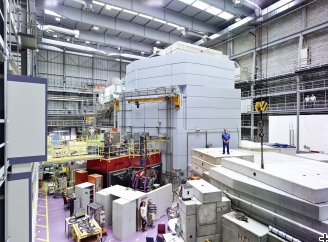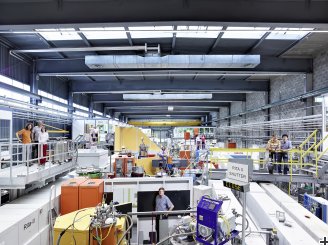Copyright 2012 neutronsources.org | All rights reserved. | Powered by FRM II | Imprint / Privacy Policy
Successful for 20 years: Probing materials with particles
Date: 18/04/2017
Source: www.psi.ch
Whether they study materials for the electronics of the future, batteries, or swords from the Bronze Age — for 20 years researchers from a range of disciplines have been using the Swiss Spallation Neutron Source SINQ of the Paul Scherrer Institute PSI for their investigations. At a symposium on 18 April, researchers looked back on the facility’s successes and presented plans for modernisation.
Twenty years ago, SINQ started operating at PSI. Since then researchers at this facility, unique in Switzerland, have been able to look into the interior of materials and objects. In their experiments, they “X-ray” the objects to be studied with a beam of neutrons. The experiments are similar to medical examinations with X-ray light, but thanks to the special properties of neutrons, they deliver different information about the objects under investigation.
Looking inside metals
Thus it is possible, for example, to look deep inside metallic objects. Archaeologists and art historians can examine bronze statues, swords, or historical musical instruments and gain insights into the methods by which they were made, all without damaging the valuable objects. With the help of neutrons at PSI, developers from industry produce images of the interior of technical devices — in some cases, even while they are running. These insights help them to understand processes that take place in the devices, and thus to improve their products. For example, chainsaws’ internal combustion engines, diesel soot particle filters, and motorcycle clutches have been studied.
Battery researchers investigate, for example, what happens inside a lithium-ion battery while it is being charged and discharged. They want to find out why the batteries charge more poorly over time and, with this knowledge, to develop technologies for more durable and effective batteries.
Understanding the properties of materials
Many researchers study materials with unusual properties that could, in the future, enable fast and energy-efficient data storage devices or even quantum computers. “Here at SINQ, though, we do not directly develop electronic components — others have to do that”, stresses Christof Niedermayer, head of the Laboratory for Neutron Scattering and Imaging at PSI. “We investigate how the special properties of materials arise and, with that, create the basis for these developments.” Neutrons are especially well suited for these studies because they sense the delicate interplay between the atoms a material is made of, and this interplay is responsible for the different properties.
Targeted drug delivery
Medicine too can profit from neutron research — for example, researchers have investigated the possibility of targeted, triggered delivery of drugs to just those areas of the body affected by disease. The medically active substances would be enclosed in liposomes — tiny spherules that are surrounded by a membrane shell. Through targeted stimulation, these liposomes can be made to open up right inside a diseased cell, so the drug is not distributed needlessly throughout the body. The structure of such liposomes can be probed with neutrons.
Open for external researchers and the education of students
Those are just a few small examples of current research topics at PSI’s neutron source. Every year, researchers conduct several hundred experiments here. Among them are not only researchers from PSI, but also numerous external users, because SINQ is open to investigators from universities, research institutes, and industry who need neutron experiments to accomplish their work. Any scientist can apply for beam time. An international board of experts selects the best projects, which can then be carried out. This offer holds for researchers from Switzerland as well as from abroad. In turn, similar or complementary facilities in other countries are open to Swiss researchers. Around half of the users at SINQ come from Switzerland. They often conduct their experiments within the framework of long-term cooperations with PSI. An important aspect of these collaborations is educating students and training young scientists for the use of these large-scale facilities.
Good user support
“There’s a host of reasons why many researchers decide to do their measurements at SINQ”, Niedermayer explains. “In surveys, many users praise in particular the very good support they get from scientists on-site, who make sure the experimental possibilities for every research question are optimally exploited. Also, every neutron research centre has certain facilities in which it has specialised. At SINQ, for example, those are the sample environments.” This equipment makes it possible to investigate materials while they are subject to extreme external conditions: That could be very low temperatures, high pressure, or strong magnetic fields. Often it is only when experiments are performed under different external influences that they yield crucial insights into specific material properties.
A long tradition
That SINQ is the only neutron source in Switzerland is due, among other things, to the investments, time, and effort that go into operating such a facility. Neutrons are among the fundamental building blocks of our matter and are constituent parts of all the things that surround us, but it is difficult to release them from the bond of the atomic nucleus. For example, the proton accelerator facility, with the large ring cyclotron as its centrepiece, stands at the beginning of the neutron production process. This machine, with a diameter of around 12 metres, accelerates protons to roughly 80 percent of the speed of light. These protons are then stopped in a block of metal. Through the violent collisions of protons with the atomic nuclei of the metal, neutrons are set free and made available for the experiments. The metal block, surrounded by a water moderator tank, is situated in a striking, three-storey-high structure of concrete and steel that dominates the main hall where some of the neutron experiments are conducted.
The proton accelerator itself is considerably older than the neutron source. It has been in operation since 1974, initially serving mainly particle physics experiments. Thanks to innovative technology, it has been possible to increase the accelerator’s power so massively over the years that it can be used for a neutron source. The tradition of neutron research at PSI, however, reaches back even farther than 20 years. Already before that time, experiments with neutrons were conducted here at two smaller neutron sources. But with the construction of SINQ, completely new scientific possibilities for research with neutrons opened up. On the one hand, the facility offers considerably more measurement stations where experiments can run simultaneously than at PSI’s earlier neutron sources. On the other hand, SINQ additionally delivers so-called “cold” neutrons: slowed-down neutrons with which, for example, biological structures and many magnetic phenomena can be probed in much greater depth.
The central role of neutron guides
In one point, SINQ was the forerunner: “SINQ was the first neutron source worldwide in which neutron guides with novel supermirrors were used throughout”, explains physicist Jürg Schefer, who has been active in neutron research at PSI for 30 years. Neutron guides are internally reflective glass channels through which neutrons are led to the experiments like optical signals in a waveguide. It is only because of these neutron guides that enough neutrons can be delivered to experiment stations 30 or 40 metres away from the source. “The super-reflective neutron guides for SINQ were developed and produced at PSI. Then, in 1999, the researchers responsible founded the spin-off company SwissNeutronics AG, which still today is very successful in developing, manufacturing, and installing ever more complex neutron guide systems. It sells these to research centres worldwide”, Schefer says.
Neutron guides are also at the heart of the current modernisation project: In the coming years, the existing guides are to be replaced by new ones that represent the state of the art in innovations. These better guides will bring more neutrons to the measuring instruments and thus improve the performance of the experiments now in place. The upgrades will also enable new methods of investigation for scientific and industrial questions.
Text: Paul Scherrer Institute/Paul Piwnicki
Contact
Prof. Dr. Christian Rüegg, Division Head, Research with Neutrons and Muons
Paul Scherrer Institute, 5232 Villigen PSI, Switzerland
Telephone: +41 56 310 47 78
e-mail: christian.rueegg@psi.ch
Prof. Dr. Christof Niedermayer, Head of the laboratory Neutron Scattering and Imaging
Paul Scherrer Institute, 5232 Villigen PSI, Switzerland
Telephone: +41 56 310 20 86
e-mail: christof.niedermayer@psi.ch

